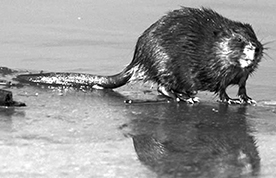LAKE ONTARIO PLAN HURTS HOMEOWNERS, HELPS MUSKRATS AND NYPA
By James Hufnagel
 |
| Lake Ontario's waters will rise with new plan, affecting homeowners |
 |
| Muskrat may see a boost in numbers |
A new, US-Canadian plan is in the works to raise the water levels and enlarge Lake Ontario.
There may be profound implications for shoreline property owners, from Youngstown to Oswego and Niagara County's multimillion dollar Lake Ontario waterfront economy.
The plan, called "BV7," is a proposal of the International Joint Commission (IJC), which is in charge of matters relating to shared waters of the US and Canada including the Great Lakes and St. Lawrence Seaway.
The BV7 plan is nearly identical to one introduced four years ago by the IJC and ultimately shelved after public outcry.
Shoreline property owners who have looked on helplessly as, year after year, the pounding waves of Lake Ontario swallowed backyards, docks and decks, and even houses are concerned higher water levels will make matters worse.
The BV7 plan, if approved, will impose more man-made control of lake levels. The plan calls for an increase of overall lake levels and greater seasonal fluctuations of the waters of Lake Ontario.
According to Timothy Horanburg, Supervisor of Newfane and Olcott, boaters, marinas and charter fishing businesses are already suffering from fluctuating water levels. Visitors, from all over the country, who have come for years to enjoy local fishing, sailing and tourism are leaving for Michigan, Ontario, or other lake areas where water height changes do not make docking and maintaining pleasure craft as much of a challenge. Many in the local fishing and boating tourism business see the plan as a potential tipping point and fear it will change Niagara county’s Lake Ontario tourism business. Olcott Beach won the “Ultimate Fishing Town” contest conducted by the World Fishing Network for 2012 with 135,000 votes.
Homeowners with shoreline properties are deeply concerned. On June 5, more than 400 local residents packed the Olcott Volunteer Fire Hall for a public hearing on the plan. Speakers were limited to two minutes at the microphone, which upset many. Local politicians addressed the crowd, but no IJC commissioner was in attendance. The meeting was moderated by an IJC Public Information Officer, Frank Bevacqua. Most speakers were opposed to the plan. Several said they believed the sole purpose for the session was to provide the public an opportunity to blow off steam. At one point, a reluctant DEC official was called to the podium, where he nervously stammered out the answer to the question that his agency approved BV7.
On the other side, a combination of shipping, hydropower and wildlife habitat, global warming, and environmental interests support the plan.
A IJC booklet "Lake Ontario and the St. Lawrence River - A New Path Forward," addresses some of the rationale for increasing the water levels of Lake Ontario: the threat of Global warming and the drying up of Lakes.
"The conditions of the future will be different from those of today... The (present Lake Ontario water level management plan, in place since 1960) is designed for past conditions, not future ones... A new approach needs to include a system for monitoring... how global climate change may affect future water supplies."
The plan also increases water to marshes and wildlife habitat bordering Lake Ontario.
The plan states "Lake Ontario and upper St. Lawrence coastal wetlands provide breeding and feeding grounds for most coastal life" and "have a direct influence on the breeding and nesting habits of marsh birds, fish and amphibians." The increased water levels are anticipated to "create more variety in marsh plants, which creates a more productive and robust coastal ecosystem."
Rounding out BV7, and what many critics believe is the real reasonfor the plan are that "Commercial navigation could see fewer delays in the Montreal-St. Lawrence section" and "The more stable and predictable flows would be expected to provide economic benefits to the regions' hydropower plants."
At the crux of the issue is the question of whether enlarging Lake Ontario, which will effect hundreds of local properties, some which may be engulfed into the waters, a true environmental measure or an excuse to increase profitability for upstate NYPA in order to produce more hydropower to New York City.
ENVIRONMENT AT CORE OF LAKE ONTARIO PLAN?
The IJC plan was created by the Lake Ontario-St. Lawrence River Working Group, (LOSLR) a subcommittee of the IJC.
LOSLR is comprised of two delegates each from New York State, Ontario, Quebec, the federal governments of the US and Canada, and the parent IJC. The New York State representatives is the Commissioner of the Department of Environmental Conservation (DEC), Joseph Martens, and New York Deputy Secretary of State, Deidre Scozzafava.
Scozzafava was the New York State Assembly member from the 122nd district which includes St. Lawrence County (home to the NYPA hydropower plant that benefits from BV7).
The plan addresses the impact on various wildlife species. Among those affected, the King Rail, Black Tern, and Virginia Rail, (birds) "preferred breeding habitat" and "reproductive index" will improve.
The muskrat’s "house density in drowned river mouth wetlands" will improve thier population significantly.
The DEC promotes muskrat hunting in New York State because of overpopulation.